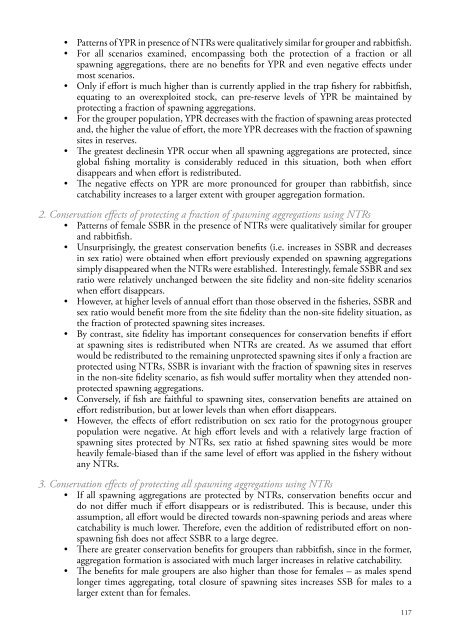WIOMSA-CORDIO spawning book Full Doc 10 oct 13.pdf
WIOMSA-CORDIO spawning book Full Doc 10 oct 13.pdf
WIOMSA-CORDIO spawning book Full Doc 10 oct 13.pdf
Create successful ePaper yourself
Turn your PDF publications into a flip-book with our unique Google optimized e-Paper software.
• Patterns of YPR in presence of NTRs were qualitatively similar for grouper and rabbitfish.• For all scenarios examined, encompassing both the protection of a fraction or all<strong>spawning</strong> aggregations, there are no benefits for YPR and even negative effects undermost scenarios.• Only if effort is much higher than is currently applied in the trap fishery for rabbitfish,equating to an overexploited stock, can pre-reserve levels of YPR be maintained byprotecting a fraction of <strong>spawning</strong> aggregations.• For the grouper population, YPR decreases with the fraction of <strong>spawning</strong> areas protectedand, the higher the value of effort, the more YPR decreases with the fraction of <strong>spawning</strong>sites in reserves.• The greatest declinesin YPR occur when all <strong>spawning</strong> aggregations are protected, sinceglobal fishing mortality is considerably reduced in this situation, both when effortdisappears and when effort is redistributed.• The negative effects on YPR are more pronounced for grouper than rabbitfish, sincecatchability increases to a larger extent with grouper aggregation formation.2. Conservation effects of protecting a fraction of <strong>spawning</strong> aggregations using NTRs• Patterns of female SSBR in the presence of NTRs were qualitatively similar for grouperand rabbitfish.• Unsurprisingly, the greatest conservation benefits (i.e. increases in SSBR and decreasesin sex ratio) were obtained when effort previously expended on <strong>spawning</strong> aggregationssimply disappeared when the NTRs were established. Interestingly, female SSBR and sexratio were relatively unchanged between the site fidelity and non-site fidelity scenarioswhen effort disappears.• However, at higher levels of annual effort than those observed in the fisheries, SSBR andsex ratio would benefit more from the site fidelity than the non-site fidelity situation, asthe fraction of protected <strong>spawning</strong> sites increases.• By contrast, site fidelity has important consequences for conservation benefits if effortat <strong>spawning</strong> sites is redistributed when NTRs are created. As we assumed that effortwould be redistributed to the remaining unprotected <strong>spawning</strong> sites if only a fraction areprotected using NTRs, SSBR is invariant with the fraction of <strong>spawning</strong> sites in reservesin the non-site fidelity scenario, as fish would suffer mortality when they attended nonprotected<strong>spawning</strong> aggregations.• Conversely, if fish are faithful to <strong>spawning</strong> sites, conservation benefits are attained oneffort redistribution, but at lower levels than when effort disappears.• However, the effects of effort redistribution on sex ratio for the protogynous grouperpopulation were negative. At high effort levels and with a relatively large fraction of<strong>spawning</strong> sites protected by NTRs, sex ratio at fished <strong>spawning</strong> sites would be moreheavily female-biased than if the same level of effort was applied in the fishery withoutany NTRs.3. Conservation effects of protecting all <strong>spawning</strong> aggregations using NTRs• If all <strong>spawning</strong> aggregations are protected by NTRs, conservation benefits occur anddo not differ much if effort disappears or is redistributed. This is because, under thisassumption, all effort would be directed towards non-<strong>spawning</strong> periods and areas wherecatchability is much lower. Therefore, even the addition of redistributed effort on non<strong>spawning</strong>fish does not affect SSBR to a large degree.• There are greater conservation benefits for groupers than rabbitfish, since in the former,aggregation formation is associated with much larger increases in relative catchability.• The benefits for male groupers are also higher than those for females – as males spendlonger times aggregating, total closure of <strong>spawning</strong> sites increases SSB for males to alarger extent than for females.117


















